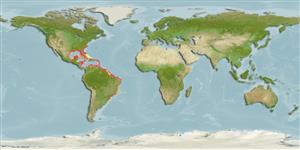Environment: milieu / climate zone / depth range / distribution range
Écologie
marin récifal; profondeur 1 - 100 m (Ref. 9710). Tropical; 38°N - 33°S
Western Atlantic: Virginia, USA and northern Gulf of Mexico to Brazil; not occurring in Bermuda.
Taille / Poids / Âge
Maturity: Lm ? range ? - ? cm
Max length : 35.0 cm TL mâle / non sexé; (Ref. 26340); common length : 20.0 cm TL mâle / non sexé; (Ref. 5217)
Épines dorsales (Total): 12; Rayons mous dorsaux (Total): 9; Épines anales 3; Rayons mous anaux: 5. Occipital pit present; two spines on part of preorbital overlapping maxillary; supplemental preopercular spine present; dark brown spots on inner part of pectoral fin (Ref. 13608).
Commonly found in bays, harbors, and on the continental shelf. Inhabits soft bottoms. Traded as an aquarium fish at Ceará, Brazil (Ref. 49392).
Life cycle and mating behavior
Maturité | Reproduction | Frai | Œufs | Fécondité | Larves
Robins, C.R. and G.C. Ray, 1986. A field guide to Atlantic coast fishes of North America. Houghton Mifflin Company, Boston, U.S.A. 354 p. (Ref. 7251)
Statut dans la liste rouge de l'IUCN (Ref. 130435)
Menace pour l'homme
Venomous
Utilisations par l'homme
Aquarium: Commercial
Plus d'informations
Taille/ÂgeCroissanceLongueur-poidsLongueur-longueurFréquences de longueursMorphométrieMorphologieLarvesDynamique des populations larvairesRecrutementAbondanceBRUVS
RéférencesAquacultureProfil d'aquacultureSouchesGénétiqueElectrophoresesHéritabilitéPathologiesTraitementNutrientsMass conversion
CollaborateursImagesStamps, Coins Misc.SonsCiguateraVitesseType de nageSurface branchialeOtolithesCerveauxVision
Outils
Articles particuliers
Télécharger en XML
Sources Internet
Estimates based on models
Preferred temperature (Ref.
123201): 21.8 - 27.9, mean 25.5 °C (based on 528 cells).
Phylogenetic diversity index (Ref.
82804): PD
50 = 0.5000 [Uniqueness, from 0.5 = low to 2.0 = high].
Bayesian length-weight: a=0.01318 (0.00626 - 0.02776), b=3.03 (2.86 - 3.20), in cm total length, based on LWR estimates for this Genus-body shape (Ref.
93245).
Niveau trophique (Ref.
69278): 3.8 ±0.4 se; based on diet studies.
Résilience (Ref.
120179): Milieu, temps minimum de doublement de population : 1,4 à 4,4 années (Preliminary K or Fecundity.).
Fishing Vulnerability (Ref.
59153): Low vulnerability (25 of 100).
Nutrients (Ref.
124155): Calcium = 45.5 [23.3, 98.5] mg/100g; Iron = 0.542 [0.289, 1.536] mg/100g; Protein = 18.6 [16.9, 20.2] %; Omega3 = 0.215 [0.098, 0.569] g/100g; Selenium = 36.2 [19.8, 87.1] μg/100g; VitaminA = 114 [40, 307] μg/100g; Zinc = 1.2 [0.8, 1.7] mg/100g (wet weight);
